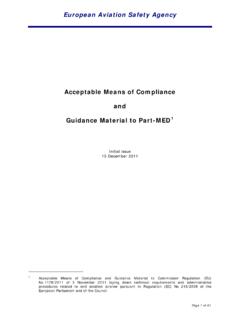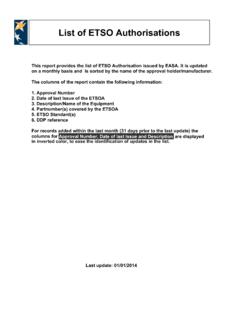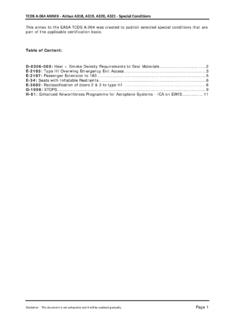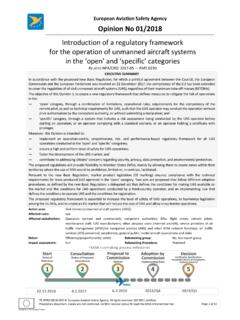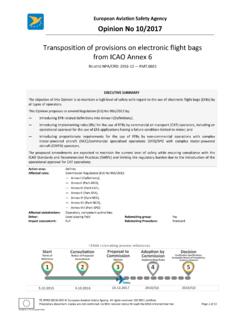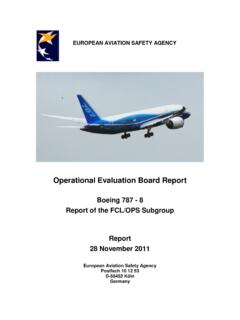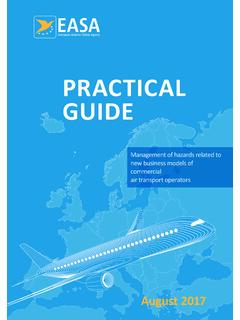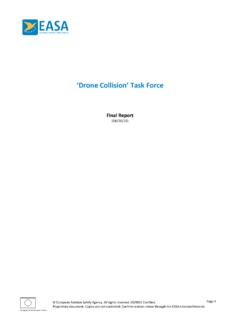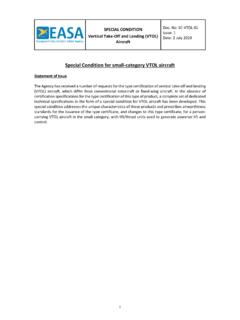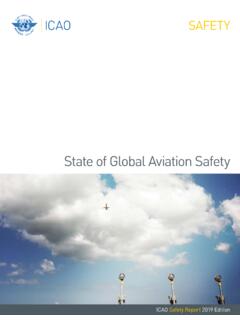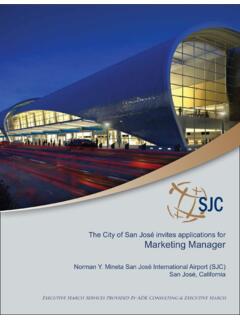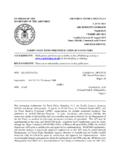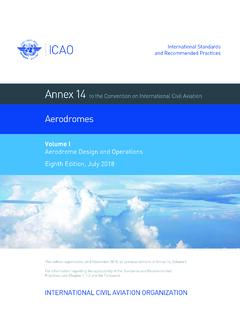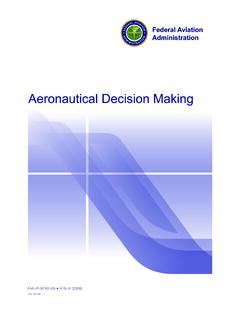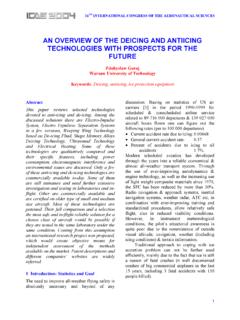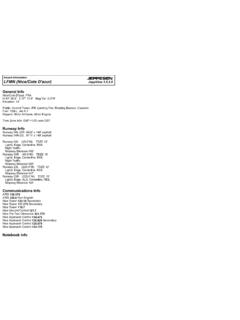Transcription of GUIDANCE ON HAZARDS IDENTIFICATION
1 Safety Management System and Safety Culture Working Group (SMS WG) GUIDANCE ON HAZARDS IDENTIFICATION Authors: Ilias Maragakis, EASA Stephen Clark, NATS Michel Piers, NLR Capt Dave Prior, easyJet Carmela Tripaldi, ENAC Michel Masson, EASA Cl ment Audard, EASA Safety Management System and Safety Culture Working Group GUIDANCE on Hazard IDENTIFICATION - March 09 EXECUTIVE SUMMARY Safety risk assessment is one of the functions in a Safety Management System and an important element of safety risk assessment is the IDENTIFICATION of HAZARDS . A hazard can be considered as a dormant potential for harm which is present in one form or another within the aviation system or its environment.
2 This potential for harm may be in the form of a natural hazard such as terrain, or a technical hazard such as wrong runway markings. This document develops the concept of the hazard within a safety risk management framework which also defines risk, safety events, undesirable events, outcomes, consequences and risk controls (barriers or mitigations). The basic concepts behind hazard IDENTIFICATION methodologies (data-driven and qualitative) are described. It is acknowledged however that it is difficult to declare completeness of a HAZARDS IDENTIFICATION process, and hence hazard IDENTIFICATION should be periodically reviewed.
3 Moreover, it is further recognised that the aviation system involves a complex interaction between technical and human-centred sub-systems operated by a wide range of different stakeholders (Airlines, Airports, ANSP and MRO etc.). Each organisation should manage the HAZARDS that fall within their managerial control, but should also co-operate with other stakeholders to help manage interactions and interfaces. A number of specific tools and techniques for HAZARDS IDENTIFICATION are summarised and their advantages and disadvantages noted. These tools and techniques include: Brainstorming Hazard and Operability Studies (HAZOPS) Checklists Failure Modes and Effects Analysis (FMEA) Structured What-if (SWIFT) Dynamic Models Future HAZARDS IDENTIFICATION through FAST method Another key step in the safety risk assessment process is safety assessment documentation and the use of Hazard Logs to document the output of HAZARDS IDENTIFICATION is also described and an example hazard log template provided.
4 Some examples of HAZARDS and information sources that could be used to identify HAZARDS are also provided as annexes. Disclaimer: All information provided is of a general nature only and is not intended to address the specific circumstances of any particular individual or entity. It may be used as a tool of GUIDANCE but under no circumstances it may substitute officially adopted legislative and regulatory provisions such as Acceptable Means of Compliance or GUIDANCE Materials. It is not intended and should not be relied upon, as any form of warranty, representation, undertaking, contractual, or other commitment binding in law upon ESSI/ECAST, its participants or affiliate organisations.
5 The adoption of such recommendations is subject to voluntary commitment, and engages only the responsibility of those who endorse these actions. Consequently the ESSI/ECAST and its participants or affiliate organisations, accept no responsibility or liability whatsoever with regard to the content or for any actions resulting from the use of the information contained in these recommendations. Safety Management System and Safety Culture Working Group GUIDANCE on Hazard IDENTIFICATION - March 09 Contents 1 Introduction to HAZARDS IDENTIFICATION .
6 4 2 Definitions ..4 3 HAZARDS IDENTIFICATION in Data Driven Methodologies ..9 Qualitative Methodologies ..9 HAZARDS IDENTIFICATION Documentation and Review .. 10 Interfaces between Systems and Stakeholders .. 11 4 Specific Tools and Techniques for HAZARDS 11 11 Hazard and Operability (HAZOP) Study .. 12 13 Failure Modes and Effects Analysis (FMEA).. 13 Structured What-if (SWIFT) .. 14 Dynamic 14 Future HAZARDS IDENTIFICATION through the FAST method .. 15 5 The Hazard Log .. 15 Annex I: Abbreviations and 17 List of abbreviations .. 17 List of References .. 17 Annex II: Examples of HAZARDS .
7 18 Annex III: Examples of Sources for Identifying 20 Safety Management System and Safety Culture Working Group GUIDANCE on Hazard IDENTIFICATION - March 09 1 Introduction to HAZARDS IDENTIFICATION Amendment 30 of ICAO Annex 6 requires organisations to establish Safety Management Systems (SMS) that, as a minimum: identifies safety HAZARDS ; assesses risks; ensures that remedial action necessary to maintain an acceptable level of safety is implemented; provides for continuous monitoring and regular assessment of the safety level achieved; and aims to make continuous improvement to the overall level of safety.
8 An SMS is a systematic and organised approach to managing safety, including the necessary organisational structures, accountabilities, policies and procedures. The component of SMS within which HAZARDS IDENTIFICATION takes place is safety risk assessment and this forms part of an overall safety risk management process. Safety risk assessment can be performed on steady-state operations to provide assurance that the risks associated with day-to-day operations remain tolerably safe. It can also be performed on proposed changes to a system or operation to ensure that the risks from any additional HAZARDS or any impacts on existing HAZARDS , introduced by the change remain acceptably safe.
9 Safety risk assessment features 8 steps: 1. System / operation description 2. HAZARDS IDENTIFICATION processes 3. Consequence analysis 4. Causal analysis 5. Evaluation of risk 6. Mitigation of risk 7. Approval of residual risk 8. Safety assessment documentation This article focuses on Step 2 - HAZARDS IDENTIFICATION processes, but also touches on the other steps at a high level in so far as they relate to HAZARDS IDENTIFICATION in the wider safety risk management process. 2 Definitions This section does not aim to contribute with new definitions related to safety management to the numerous ones already available, but rather to provide a better understanding of their use within this document.
10 To this end the definitions below are provided as assistance in understanding the terminology within this document and not as a proposition for amending or enriching existing definitions established by other sources. Safety Management System and Safety Culture Working Group GUIDANCE on Hazard IDENTIFICATION - March 09 The use of the term hazard in the formal risk assessment context originated in the nuclear and chemical industries for which a wide range of different types of HAZARDS are present all of the time ( nuclear material, flammable gases, toxic chemicals etc.).
